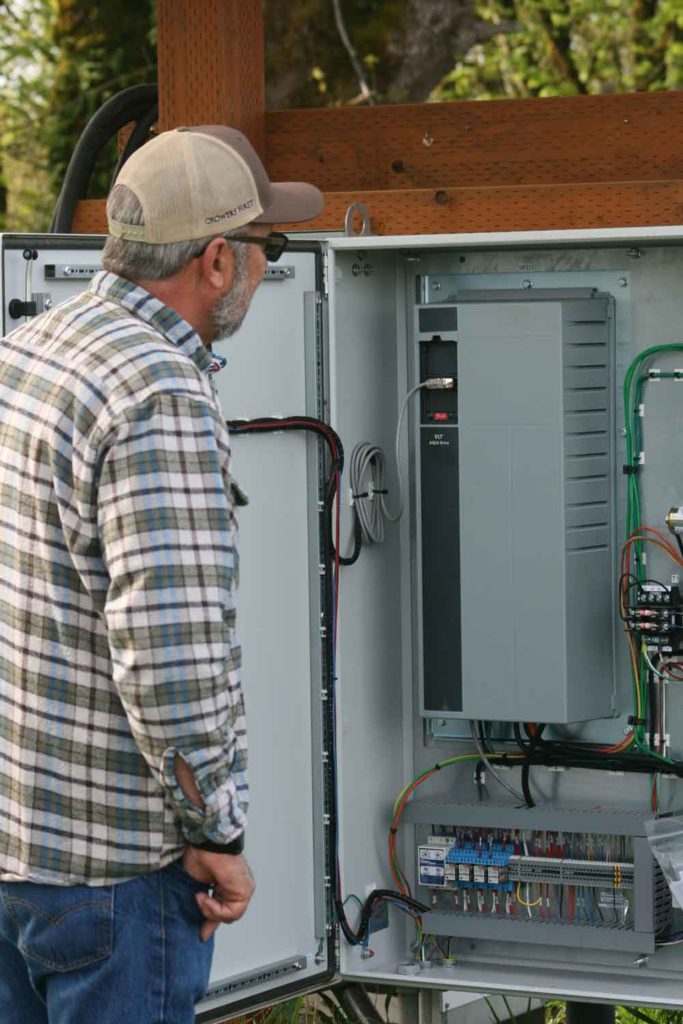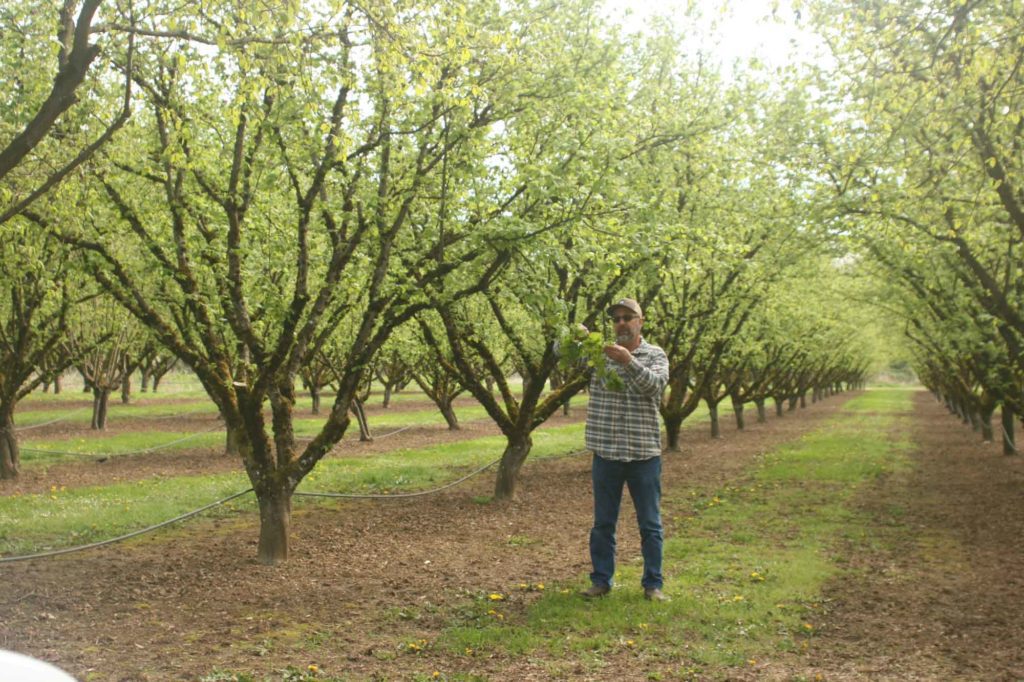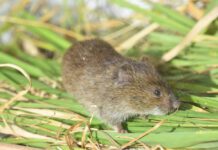
(All photos courtesy of Danita Cahill)
The census is in: drip irrigation produces bigger hazelnut trees faster, more nuts sooner, and fuller, heavier kernels. With drip irrigation, hazelnut production is now possible in dry soils with low-clay content, instead of only in historically-used prime soils.
“Drip irrigation is increasingly being adopted. It really has enhanced orchard establishment,” said Nik Wiman, Assistant Professor, Orchard Crops Extension Specialist at Oregon State University (OSU) Wiman Lab. “Grows trees a lot faster. We’re seeing nuts by year four.”
Benefits of Drip Irrigation on Established Trees
Jeff Newton, farm manager for Crimson West/Christensen Farms in McMinnville, Oregon, got in on the ground floor with hazelnut drip irrigation. He partnered with OSU extension service and Crop Production Services, and in 2011, installed a drip system into a 100-acre orchard of two-year-old Jefferson trees. Like Wiman, Newton sees a higher yield sooner with drip irrigation. Dryland trees in poor soil might take anywhere from five to seven years to produce their first crop. With drip irrigation, he’s seeing three-year-old trees in their fourth-leaf producing. Once the trees are yielding, there are additional benefits. “You double your nut crop. Fill your kernels up,” he said.
Not only does Newton champion drip irrigation, he’s also a firm believer in fertigation. His reasoning is logical: why just water the trees when you can also be feeding them? Using 250-gallon tanks and electric fertilizer injectors, he constantly injects fertilizer through his drip tubes. Amounts vary depending on factors such as the age of trees. A two-year-old orchard may require only seven gallons of fertilizer per acre. A seven-or-eight-year-old orchard is more likely to need 40-50 gallons per acre. The particular fertilizer cocktail Newton mixes depends on a wide range of variables: not only tree age, but the stage of growth and nut development, the season, the weather, the soil type and the variety. “Every variety has a different analysis of what they need or want,” he said.
Pumping Water
As for their irrigation systems, Christensen Farm pumps water from the Yamhill River. With 3,000 acres in hazelnut production, they utilize several different systems to serve their many orchards. Included among those systems is a 100-horse-power, 48-inch pump, which pumps 750-gallons per minute to a 145-acre orchard (five gallons per acre per minute). A variable frequency drive (VFD) starts the pump and controls output. The river water is run through a sand filter and then piped through 10-inch underground mainlines to the orchard. A piece of flexible hose juts from the ground at the head of each row of trees, to which the drip line is attached. Either five-eighths or three-quarter-inch lines are used, depending on how far the water is being pumped. The drip lines are pressure compensated and have emitter holes punched every three feet. Each emitter releases half-a-gallon of water per hour.
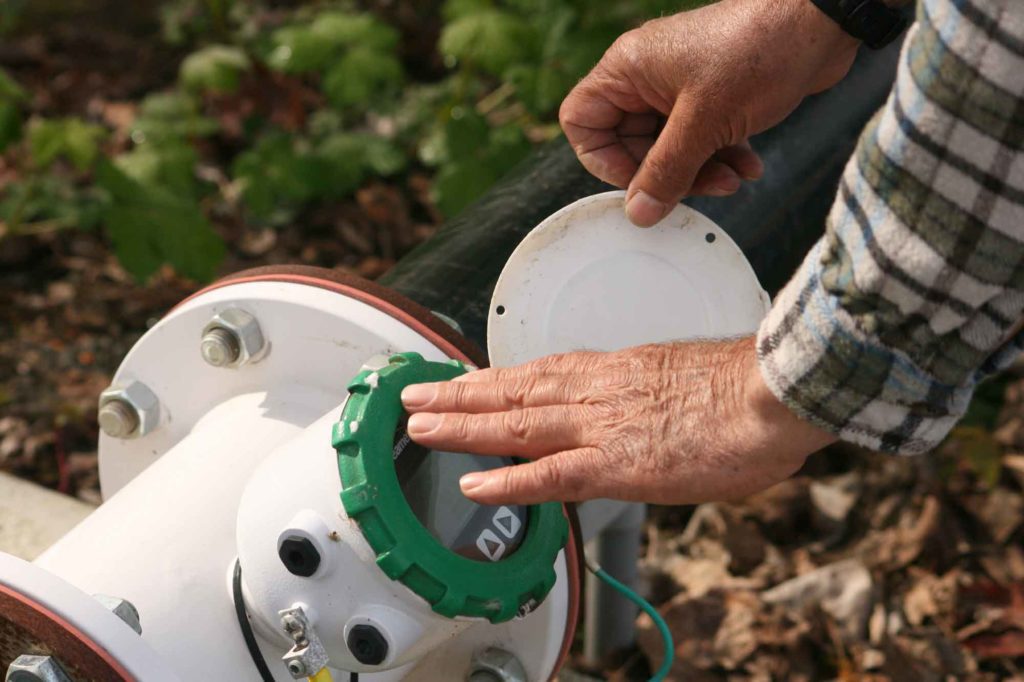
Moisture-measuring Tools
Newton irrigates during the Willamette Valley’s dry months of June, July and August. He doesn’t leave the systems running constantly, but turns them on and off depending on moisture readings.
Naturally curious and scientifically minded, Newton relies on observation and measurement to determine how much water and nutrients the trees need. The more water a tree expires through its leaves, the more water that tree must take up through its roots to continue robust growth. Newton has several different moisture-measuring tools in his arsenal. One of his favorites is a device that measures sap flow. Two probes are tapped into the tree to measure water flow up the trunk. He also uses various devices to measure leaf moisture and nutrient levels, and soil moisture.
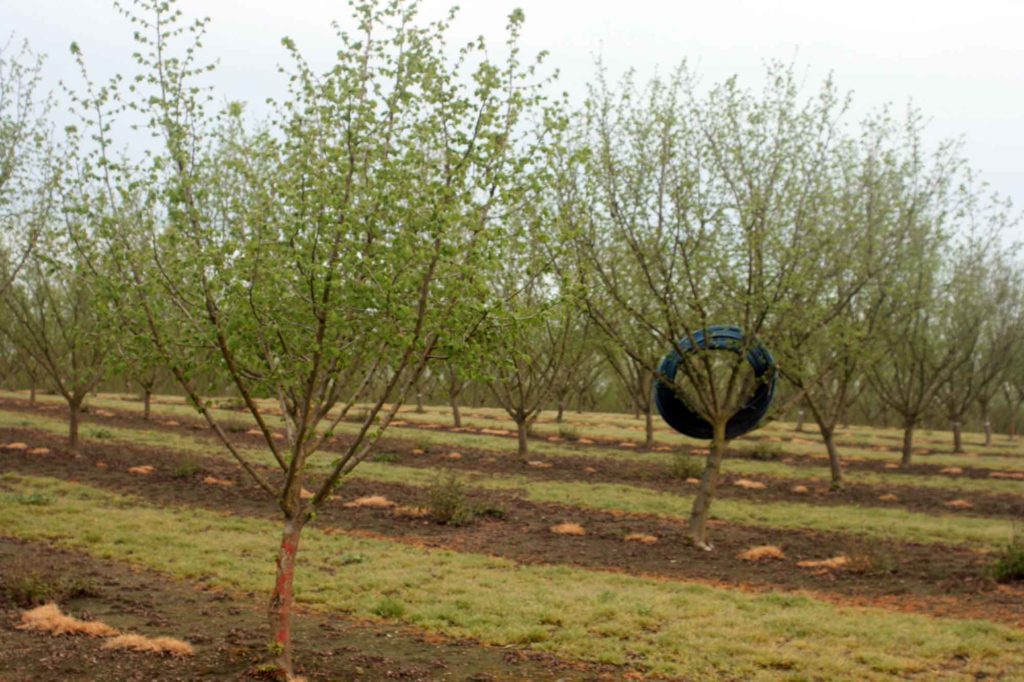
Irrigation Research Continues
More OSU research is underway. Some of those studies take place at Christensen Farms in the form of a specialized weather station installed each spring by students from the engineering
department. The station measures things like solar flux to discover how much water, exactly, a tree needs for optimum growth. Since hazelnuts are a fairly shallow-rooted plant without a largetaproot, 80-percent of the water absorption comes from the top 18-inches of the soil layer, according to Newton. So, Newton is experimenting with spreading the water and nutrients over a wider swath around the tree’s base. To do that, he’s using two, and even three, drip lines in the older orchards. “We’ve been doing this a lot of years, but what we learned last year doesn’t apply because the trees are bigger now,” he said.
As for measureable results, a 22-acre, drip-irrigated orchard of seventh-leaf trees produced 2,000 pounds of nuts last year. In two other nearby orchards, Newton invites farm visitors to compare the trees’ size and health. Both orchards were planted in the early 2000s with the Lewis variety. One orchard is irrigated. The other is not. The irrigated trees are noticeably larger and healthier.
Things to Consider Before Installing a Drip System
Before installing a drip system, there are several things to consider. It takes a significant initial outlay of money to reap the benefits of higher-weight yields down the road. Besides cost, other factors are soil type, if you hold water rights, and maintenance of irrigation lines and equipment:
- If your soil is quick draining, such as in the southern Willamette Valley, a drip system may not be able to keep up. In that case, a micro-sprinklerirrigation system may be a better bet.
- You must hold state-granted water rights in order to pump water from a river, creek or irrigation well.
- As far as maintenance, Newton pulls the pumps and stores them before winter floods, and sets them up again around the first of June. Irrigation line is rolled up during months it’s not in use and the rolls are hung out of the way in the hazelnut trees.
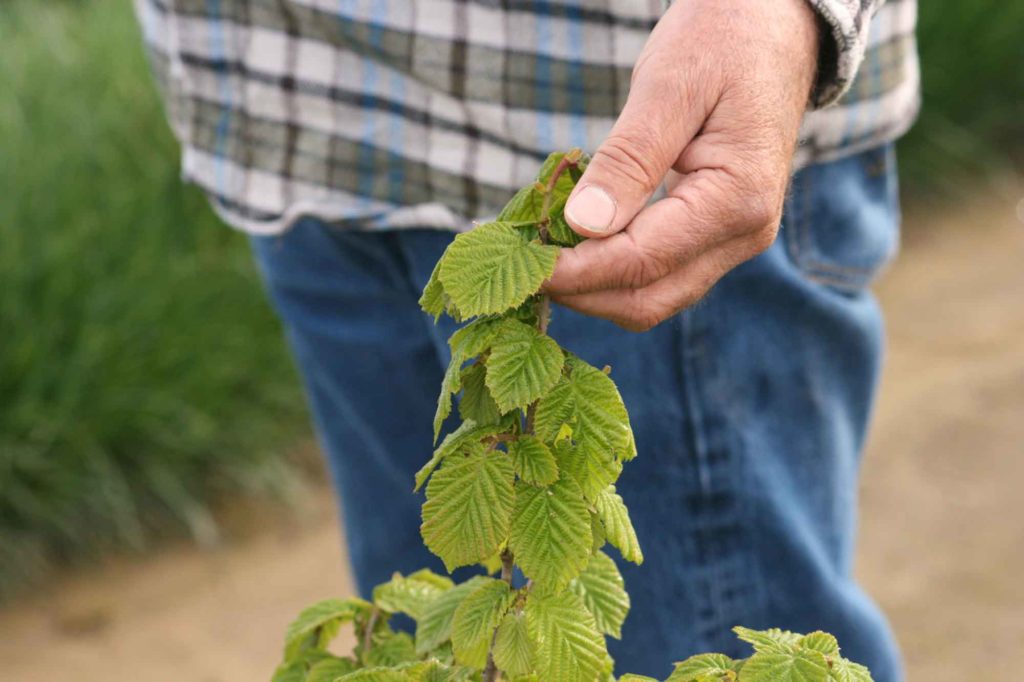
Sometimes lines have to be repaired or replaced. “Coyotes chew them,” Newton said. “Flail choppers are hard on them,” he added. Chemicals can clog the lines. Depending on type of water, minerals and debris can also clog the lines. A filtration system is good insurance, but adds additional expense.
Chemicals can clog the lines. Depending on type of water, minerals and debris can also clog the lines. A filtration system is good insurance, but adds additional expense.
What sort of system should a grower consider? That depends on budget and preferences. “You can get fancy and run it from your phone,” Newton said, although he, personally, prefers a more hands-on approach. “I need to go out there and look. You need to see your trees every day, every week, every month—see what’s going on.”
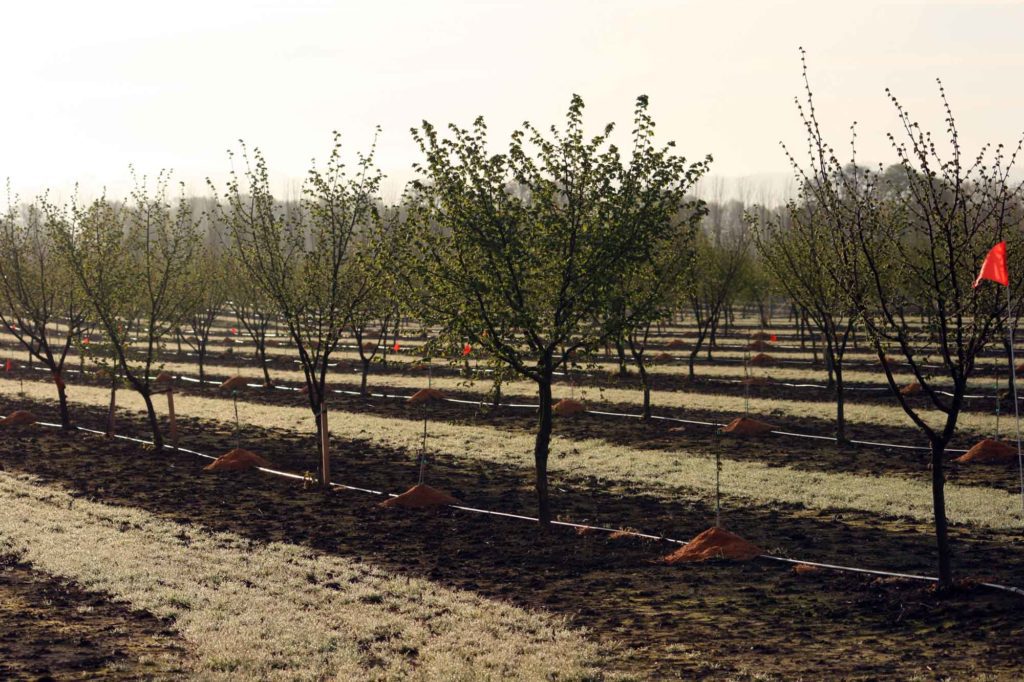
Hazelnut Drip System Costs
Costs can vary greatly, according to Anthony Tasselli of Ernst Irrigation in St. Paul, Oregon, “It depends on the amount of water you’re moving at one time. Typically, growers are looking for 6-12 gallons per minute per acre.”
Ernst Irrigation has installed systems for as low as $250 per acre. That figure is for a single-button emitter per tree and one gallon of water per minute per acre. Costs can climb as high as $1,100 per acre, which is for 12 gallons of water per minute per acre with emitter-line holes punched every 24 to 48 inches.
To break down some of those costs: for a 20-acre orchard, the price for a low-grade, 10-horse pump can start at a few hundred dollars. For an ag-quality, 10-horse centrifugal pump, expect to pay around $2,200.
For a 100-acre orchard, a 30-horse pump “at a useful pressure,” of around 650-gallons per minute, or six-and-one-half-gallons per acre per minute, Tasselli said, would cost around $4,100. There are some ancillary fittings needed, such as suction and discharge fittings to get the system up and running. Expect an additional expense of a couple thousand dollars for those. A variable frequency drive would add another $7,500.
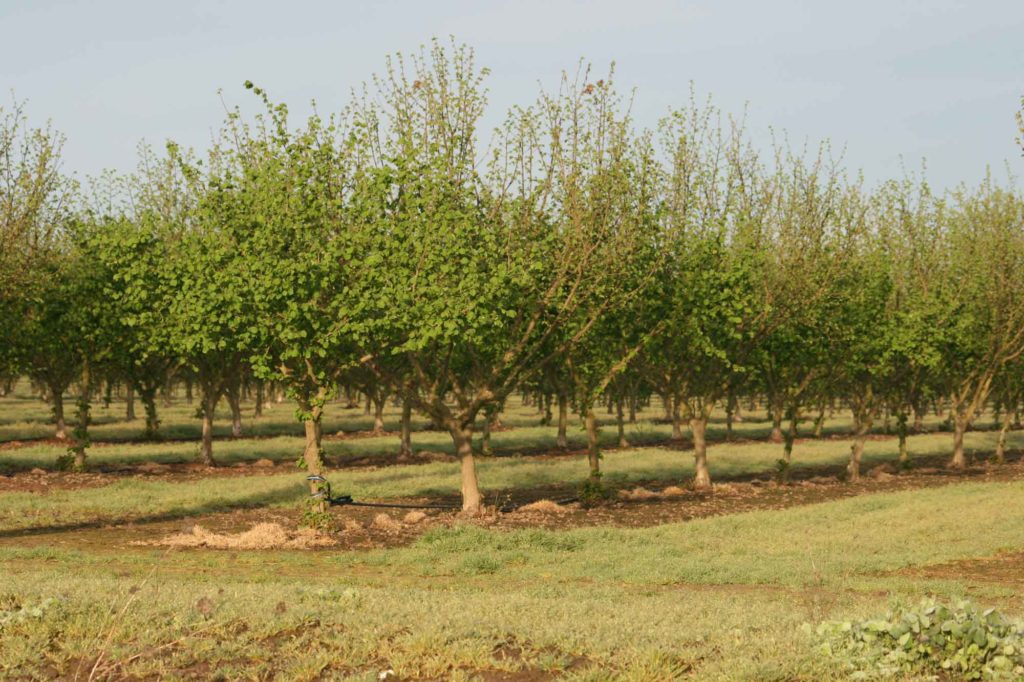
There are two types of filtration systems: disc systems and sand filters. For 300 gallons of flow per minute or more, either system would cost roughly the same, around $2,200. Tasselli favorssand filtration.
As for the life expectancy of a system, Tasselli said growers can expect to get 15-20 years for the most reliable, long-term drip-irrigation infrastructure, if it’s flushed and maintained.
If a grower wants to fertigate, a fertilizer injection pump for a 30-horse water pump system will cost from one thousand to a few thousand dollars.
When installing irrigation into young orchards, growers should consider the future water requirements needed as their trees grow and mature. More and more, Tasselli is seeing growers install drip irrigation into mature orchards. “The ability to fertigate through the drip, I think, will be a huge benefit for those older trees,” Tasselli said.
